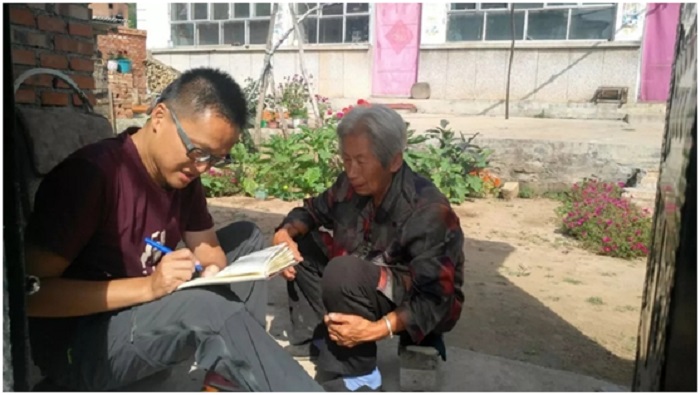



In August 2018, People’s Daily sent Lyu Xiaoxun to Yuying village, Luanping county in North China’s Hebei Province.
He was not there to report the news, but to serve as First Secretary of the Communist Party of China (CPC) Yuying village committee. His only mission was to alleviate poverty in the village. Due to scarce resources and poor transportation, one-third of Yuying village’s more than 900 residents were living in poverty.
Despite being full of hills and steep slopes, Yuying village has always enjoyed abundant sunshine.
In 2017, a 60-MW photovoltaic power generation project was launched in the village thanks to the help of People’s Daily.
To date, more than 200 people from the village have worked for the project. At the end of 1978, China had 770 million poor people in rural areas, where the poverty rate was as high as 97.5 percent. Since the reform and opening-up, China has seen a huge drop in its number of impoverished people. More than 93 million rural people in China have escaped poverty since the 18th CPC National Congress in 2012. China has reduced its number of poor people by more than 10 million annually for seven years in a row, which is equivalent to the entire population of a medium-sized European country. Thirty people in China escape poverty every minute.
By the end of 2019, the number of impoverished people in China’s rural areas dropped to 5.51 million, and the poverty rate was 0.6 percent. The CPC has solemnly pledged to lift all poor areas and people out of poverty by the end of 2020. Seventy years ago, China did not have adequate food and clothing for its people. How has it been able to eliminate poverty so comprehensively? To realize its poverty alleviation goals, the country sticks to the leadership of the CPC and makes full use of the political advantages of the socialist system, which enables it to pool resources to solve major problems. Provinces and cities in eastern China, which are more economically developed, have paired up with the country’s western regions to reduce poverty.
In 1996, Fujian Province on China’s southeast coast was paired with northwest China’s Ningxia Hui Autonomous Region. Xi Jinping, who was then the deputy Party chief of Fujian, visited Xihaigu, an area known as “a bitter barren land” in Ningxia, which was once labeled the “poorest place in the world.” He suggested relocating all the poor people living in uninhabitable areas and building a new residential area called “Minning village” for them. More than 20 years on, Minning village has gradually developed from nothing to Minning town, home to 66,000 permanent residents and vast stretches of vineyards, red raspberry orchards, and photovoltaic greenhouses. This “dry beach” has evolved into a “golden beach.”
China has pooled its national strength and optimized distribution of resources to push forward its massive poverty alleviation drive. The central government has poured vast resources into related tasks. Various central government departments and organs have sent tens of thousands of officials to impoverished villages to take up provisional posts and serve as first secretaries. China has adhered to the concept of adjusting measures to local conditions in order to promote development-oriented poverty alleviation in rural areas.
In 2013, Xi proposed the concept of “targeted poverty alleviation” for the first time. The concept later became the basic strategy of the country’s anti-poverty campaign.
Lyu went from door to door, visiting local people to get a clear picture of the situation of every household in Yuying village.
In addition to the photovoltaic project, he also researched the local terrain and soil conditions, and decided to grow pears and vegetables. The okra grown in the vegetable gardens and supplied to the central area of Luanping county and Beijing has brought local people good profits, helping them to achieve the aim of growing quality products to sell for a good price.
By 2019, only two people from one household in Yuying village had not escaped poverty. “With one mind, people can move mountains.” Fighting against poverty is a major undertaking that involves all of Chinese society. Various enterprises and social organizations in China have also taken part in the country’s efforts to alleviate poverty.
Over the past 70 years, China has provided relief to poor people, made development-oriented poverty alleviation efforts, and established a basic strategy of targeted poverty alleviation, carving out a poverty alleviation path with Chinese characteristics, contributing its wisdom to global poverty reduction, and creating a glorious chapter in mankind’s history of anti-poverty efforts.
Source: People’s Daily Online


The Humanitarian Service Diamond Awards has.
A Chinese Company, Inner Galaxy Steel.


The Programme Coordinator, Regulatory, Compliance and.


A Non-Governmental Organization (NGO), Committee for.
The Trustfund Pensions Limited has chided.


The House of Representatives Committee on.
The China General Chamber of Commerce.


Senator Chuka Utazi who represented Enugu.


An Abuja based Legal Practitioner, Ugochukwu.


The African business community in Yiwu,.
Leave a Comment